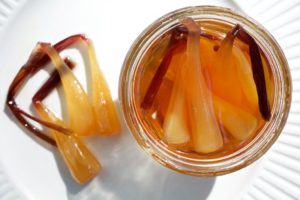Sweet and Sour Onion Pickle
By Deb Lindsey – The Washington Post
Use this onion pickle as a condiment on a sandwich or added to cheese or eggs. Use the first onions of spring, not grocery store scallions.
You will need 1 quart of non-chlorinated water and 2 half-pint canning jars with rings and new lids; see the NOTE, below.
Substitute 24 ramps or wild garlic, or combine all three, pickling only the bulbs. What about the greens or scapes that remain? Chop them and wilt in olive oil over high heat, and add to a frittata or Spanish tortilla.
Make Ahead: The onions need to marinate twice – once in salt water for 12 to 24 hours and once in the pickling brine for 12 to 24 hours. The canned onion pickle needs to cure for 2 weeks before serving. Unopened jars can be stored in a cool, dark place for up to 1 year.
SERVINGS:
Tested size: 12 servings; makes 2 half-pint jars
INGREDIENTS
-
2 tablespoons kosher salt
-
8 to 12 plump spring onions (about 12 ounces total), extremely fresh and very clean
-
3 cups apple cider vinegar
-
2 cups sugar
-
1 tablespoon pickling spice
DIRECTIONS
Fill a stainless-steel or glass bowl with 1 quart of cool, non-chlorinated water. Stir in the salt. Closely trim away the roots from the end of each onion, then cut off the greens. Add the onions to the salt water; top with a plate to keep them submerged. Drape the bowl with a tea towel and let it rest for 12 to 24 hours.
Drain the onions, rinse well under cool running water, then drain again.
Combine the vinegar, sugar and pickling spice in a nonreactive (stainless-steel) 3-quart saucepan; bring to a boil over medium-high heat, stirring until the sugar has dissolved and formed a light syrup. Add the onions; once the syrup returns to a boil, cook for 10 minutes. Remove from the heat, cover and let the mixture rest in the saucepan for 12 to 24 hours.
Prepare for water-bath canning. Bring the onions in the syrup to a rolling boil over high heat. Use a slotted spoon to lift the onions out of the syrup and pack them into the sanitized jars, filling each jar no more than two-thirds full. Boil the syrup for 5 minutes, until slightly thickened.
Add the thickened syrup to the jars, leaving 1/2 inch of head space. (You might have syrup remaining; it makes a sinful addition to a gin cocktail and a surprising sip over ice with sparkling water.)
Run a chopstick or flat plastic knife along the inside of the jars to dislodge any air bubbles. Clean the rim of each jar with distilled white vinegar to cut residual oils, place the warmed lids on and finger-tighten the rings (not too tightly). Process in the boiling water bath for 15 minutes (see NOTE, below). Turn off the heat and let the jars rest in the pot for 10 minutes. Use a jar lifter to transfer the jars to a clean, folded dish towel to cool for several hours.
Label and date the sealed jars. Store in a cool, dark place for up to 1 year. Let the onions cure for at least 2 weeks before serving, during which time any of their sharp flavor that remains will mellow.
NOTE: Water-bath canning safely seals high-acid, low-pH foods in jars. The time for processing in the water bath is calculated based on the size of the jar and the consistency and density of the food. For safety’s sake, do not alter the jar size, ingredients, ratios or processing time in any canning recipe. If moved to change any of those factors, simply put the prepared food in the refrigerator and eat within a week.
Fill a large canning kettle or deep stockpot two-thirds full with water. To keep the jars from rattling against the pot, place a rack in the pot. (A cake rack works well; a folded dish towel is equally effective.) Sanitize the jars in a short dishwasher cycle or by boiling them in a canning kettle or pot for 10 minutes. Fill a small saucepan with water and add the rings. Bring to a boil over high heat, slip in the lids and turn off the heat.
Use a jar lifter or tongs to lower the filled, sealed jars into the boiling water bath, keeping them upright. When all of the jars are in place, the water should be 1 to 2 inches above the jar tops. Add water as needed. Bring the water to a low boil before starting the timer for processing.
At the end of processing, turn off the heat and let the jars sit in the water bath until the boiling has stopped. That will reduce siphoning, in which the food burbles up under the lid, breaking the seal. Use the jar lifter or tongs to transfer the jars to a folded towel, keeping them upright. Leave the jars until they have completely cooled, at least 12 hours. Remove the rings and test the seal by lifting each jar by the lid. The lid should hold fast. Label and store in a cool, dry, dark space.


